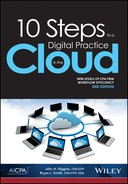3
Infrastructure
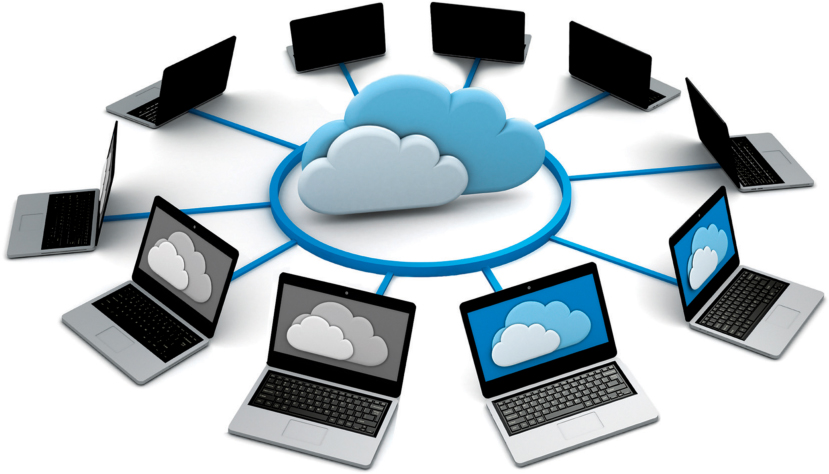
As we depicted in figure 2-1 in chapter 2, “The 10 Steps to a Digital Practice,” infrastructure is the foundation for your entire information system. Therefore, it requires nothing less than a complete focus on reliability, performance, and security. The good news is that through the use of secure data centers and cloud computing, it is much easier and more cost effective to develop a world class IT infrastructure for even the smallest accounting and tax practice.
Infrastructure Defined
If you ask ten different IT professionals to define infrastructure, you are likely to get ten different answers. However, they will all agree on the fundamental components. To help simplify the definition, table 3-1 identifies the components of infrastructure. We have put each item into one of two categories: server-based infrastructure and peripheral.
You have four basic alternative approaches to addressing your server-based infrastructure today. We have defined each of these and pointed out the pros and cons of each option in the following list:
Traditional. On-premise server infrastructure managed by internal staff.
Managed service. On-premise server infrastructure managed by external service provider via the cloud, or managed service.
Hosting, aka IaaS (infrastructure as a service). Data center hosting of server infrastructure managed by the service provider and accessed by your personnel via the cloud.
Table 3-1: IT Infrastructure Components
Infrastructure Components Server-Based Peripheral File server(s) X Network operating system X Storage drives X Firewall hardware and software X X Routers X X Switches X X Data back-up devices X Back-up power system X Data communications network hardware X X Data communication services X X Printers X Scanners X PCs/laptops/smartphones/tablets X Software as a service (SaaS). Data center hosting of server infrastructure provided by software vendor as a by-product of delivering the application via the cloud.
With the exception of option one, all the other options deploy the cloud computing model in one form or another, which is why so many people get confused about the concept. Just remember that the Internet is the cloud, and the cloud is the Internet. So when the term cloud computing is thrown around, all it really means is that the information or service is delivered via the Internet’s world wide data communications network. Notwithstanding this explanation of the cloud, when people refer to cloud computing today, they are overwhelmingly referring to the SaaS model. This is the fastest growing segment of the accounting and tax technology marketplace. Now let’s analyze these four options in detail.
Traditional On-Premise Model

We refer to this as the traditional model because it is has been the de facto infrastructure model in place in most business organizations for the past 30 years, since the advent of the personal computer. We do not need to spend a lot of time discussing this model because you are most likely all too familiar with it already.
The traditional model is based on deploying your entire infrastructure internally, or on premise, as it is referred to today. Your servers, routers, switches, peripherals, virtually all the infrastructure components listed in the preceding figure are located on-site in your office. Sometimes, they are in a well-controlled server room environment, and sometimes they are set up as a makeshift computer room in a closet or open cubicle.
The biggest challenge with this model consists of employing a network administrator with the requisite skill set to configure, deploy, and manage your infrastructure and protect the physical security of the equipment and the programs and data that are stored on it. This model has become increasingly demanding for most accounting firms because the number and complexity of the servers that need to be deployed have expanded substantially over the years. You have your primary file server for storing your software applications and shared data. You probably have a SQL server for those applications that require an SQL database. This technology alone requires a more advanced IT skill set to deploy and manage. You probably have a Microsoft Exchange server that extends your user’s Outlook applications to an enterprise solution to manage your e-mail communications and share access to calendars and common folders for information such as the enterprise’s contact database. You may have an Internet server to manage your Internet communications and possibly redundant servers to provide a measure of disaster recovery protection. The mere fact that you have multiple servers makes for a complex infrastructure to maintain. Fortunately, current server technology has evolved to a point in which these physical servers can be consolidated into a single server using “virtualization” technology, but this takes another advanced skill set to deploy and manage.
So you can understand the challenge of finding and retaining the appropriately qualified staff to handle all these complexities, let alone the capital investment that is required to procure, deploy, and manage this infrastructure. It is typical to retain some level of external support to supplement the skills and abilities of your internal staff, but this comes at an additional expense. Of the four infrastructure models discussed here, the traditional model is the only one that is clearly on a negative growth path as a result of the value proposition of the rapidly emerging cloud-based solutions.
Managed Service Model
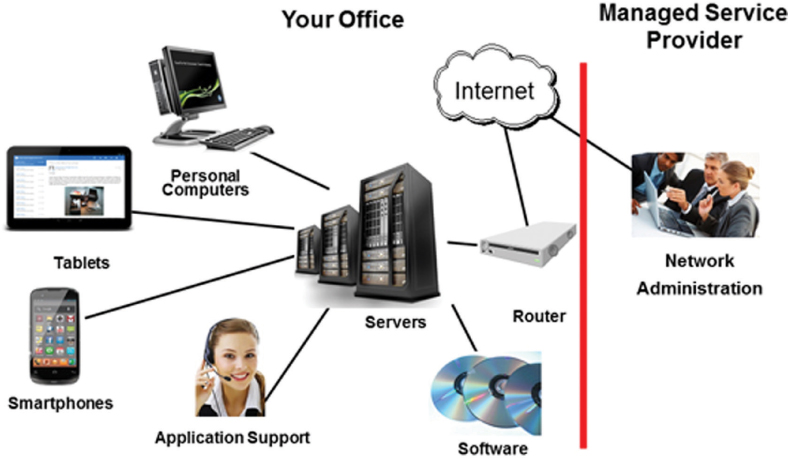
This is essentially an extension of the traditional model that leverages the cloud by utilizing the services of a dedicated external IT support organization via cloud computing. These service providers can provide virtually all your IT support requirements from their remote service center. The benefit of this is a shared services model that enables the service provider to employ a team of skilled specialists to handle all the different levels of support required. Also, through economies of scale, they can provide the service on a cost-effective basis. If you have 20 separate accounting practices, each with its own internal IT staff, there is inevitably going to be either idle capacity or a misallocation of technical resources. If all 20 firms share the services of a single managed service provider, the opportunity to establish a more effective allocation of technical resources is virtually assured.
As a point of clarification, the managed service model means that you continue to procure your own infrastructure and deploy it internally, on premise. So you still have the challenge of making the capital investments necessary to continue upgrading your information system to optimize performance and reliability. You also retain the responsibility of procuring and managing your applications software in most situations.
It is not at all uncommon to deploy a mixed model of a traditional infrastructure with some level of internal IT staff working in cooperation with the personnel from the managed service provider. So it is essentially a hybrid model. Having the service provider “team” ready and able to support your internal staff removes a major source of stress in managing your IT system.
Managed Service Value Proposition
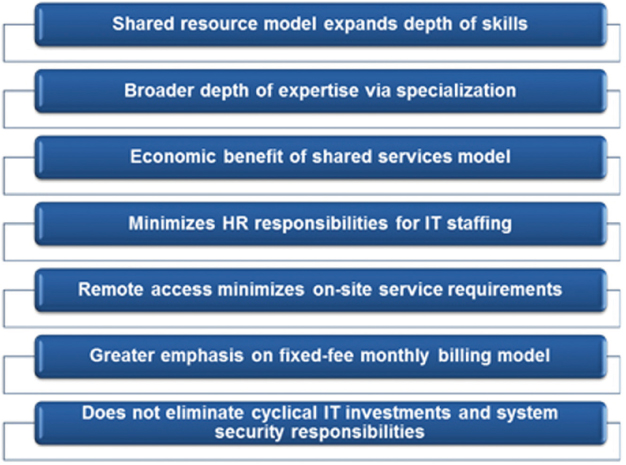
Data Center Hosting Model aka IaaS (Infrastructure as a Service)

The primary characteristic of this model is that you move your entire physical server infrastructure off-site to a secure data center that is managed by the service provider. There are different flavors of the hosting model. In some cases, you are required to provide your own server infrastructure equipment and deploy it in a secure cage (literally) at the data center, whereby all customers share access to the supporting infrastructure, including cabling, data communications, physical security measures, disaster recovery protection, and so forth. Some hosting companies provide a more comprehensive service that includes purchasing your server equipment directly from them, so that they can provide a more controlled environment to enhance the overall reliability of your infrastructure by utilizing equipment that their staff has experience with. The cloud comes into play in this model because now your personnel are accessing your remotely hosted server infrastructure via the Internet.
Data Center Hosting Value Proposition

In summary, the three models discussed thus far all have common characteristics, including investing in your infrastructure equipment and maintaining ultimate responsibility for the infrastructure and software applications. The managed service and hosting models provide for a certain level of outsourcing of your IT systems management, whereas the traditional model is all done in-house.
SaaS Model

When you hear the term cloud computing these days, it is the SaaS model that is typically being referenced. What distinguishes the SaaS model from all the other forms of cloud computing is that the focus is on the software application, rather than the infrastructure. In fact, the infrastructure is provided simply as a by-product of the application. That is the essence of where the term originated. You get everything required to run the application through your Internet browser, which makes the deployment of the application exponentially simpler than the traditional on-premise model because you do not have to worry about investing in or deploying the required infrastructure. It is delivered as part of the service.
The bottom line on the SaaS model is that it has been the fastest growing segment of the accounting and tax technology market in recent years, due primarily to the value proposition of this “turnkey” solution model.
SaaS Value Proposition
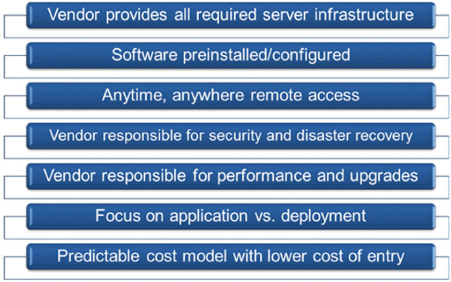
We have covered infrastructure as the first step because your strategy here has widespread implications on your entire information system model. Despite the fact that we have defined each model independently, the reality is that most firms will deploy a hybrid. The primary metric for evaluating your options is the suitability of the applications themselves. You must continually focus on deploying the applications that will optimize your ability to automate your processes. What is taking place in the marketplace today is that virtually all new software innovation is being delivered through the cloud via the SaaS model. In our opinion, it seems quite obvious that this is a paradigm shift that will eventually result in virtually all software applications being delivered in the SaaS model. The more relevant question is what is the optimal timing to move a particular application from on premise to the cloud? The answer will be different for every firm based on the current applications deployed, expansion into new applications, the state of your current IT infrastructure, and your firm’s strategy for obtaining your IT support services.
Security in the Cloud
One of the primary impediments to the adoption of cloud computing in the market place 5–10 years ago was concern about the security of information transmitted via the Internet and stored on remote Web-accessible servers. Ironically, the situation has reversed as a result of greater education and awareness of security measures that can be implemented to protect your information in the cloud. We have provided a detailed discussion of this in chapter 12, “Security and Disaster Recovery,” which focuses on security. We have also included links in appendix C, “Resource Center,” to a sample of the security specifications for a first class data center, as well as a link to detailed information on the AICPA’s new Service Organization Controls reports (formerly known as a SAS No. 70 reports). We encourage you to review this information to increase your understanding and confidence in the depth of security provided with cloud computing.
